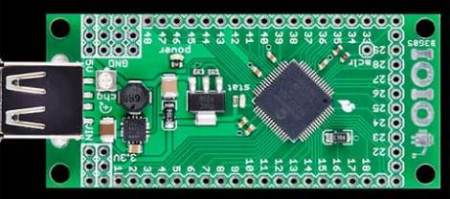
After the announcement of the Android Open Accessory ADK, [Ytai] decided he should get the the ADK running on the IOIO Android breakout board.
The first batch of Android ADK boards sold for about $400. While that price has come down considerably, the IOIO is still cheaper and smaller. [Ytai] put the source and all the technical info on his wiki.
Interestingly, this beta build is a little more capable than the Google offering. The IOIO supports the Android Debug Bridge, so it’s able to work with any Android device made since the beginning of time. The IOIO will try to communicate with the device using the Open Accessory standard because of the much better throughput and latency, but will seamlessly fall back to ADB if the device doesn’t support Open Accessory. Open Accessory boards are only comparable with devices running Android 2.3.4 and higher, so it looks like we’ve got a standard breakout board for the $99 Android tablets that fly off the shelves during Christmas.
[Ytai] has gotten a few of his projects on Hack a Day, like his PICMAN prototyping setup and his awesome 2 foot POV globe, so we’re happy to see this very skilled builder finally get his Hack a Day hat trick and enters the ranks of giants like [Sprite_tm]. If you’ve got a great build, send it in and you might be able to join the pantheon of great builders.















i guess this is the right wiki link http://codaset.com/ytai/ioio/wiki
Thank you max. Fixed the link.
So can you use this on a PC with Linux or Windows? Seems like a really cools way to ad IO to any USB system.
If you added a CAN bus driver to this you could do some interesting things with a car mounted table.
Outstanding!!
Gotta love open source hardware/software! We’re so fortunate to have Android supported by such a huge following. Normally you don’t see something useful and customizable with mega-corporate funding.
I’m a happy hacker!
C
@lwatcdr
I was wondering the same when I first saw the device. I read that some people have done it but I haven’t actually seen anything yet (first comment: swantron.com/ioio-android-breakout-board/). I would buy this in an instant if it supported Windows or Linux.
Congrats ytai!
While I’m nowhere near this league, it IS neat to think that I could get into this stuff just by owning an android device.
Interesting read.
I really hope this works, seems like weirdo upstairs is a freaken
good
HACKER!
The IOIO (pronounced “yo-yo”) is a board specially designed to work with your Android 1.5 and later device. The board provides robust connectivity to an Android device via a USB or Bluetooth connection and is fully controllable from within an Android application using a simple and intuitive Java API – no embedded programming or external programmer will ever be needed!
The IOIO board contains a single MCU that acts as a USB host and interprets commands from an Android app. In addition, the IOIO can interact with peripheral devices in the same way as most MCUs. Digital Input/Output, PWM, Analog Input, I2C, SPI, and UART control can all be used with the IOIO. Code to control these interfaces is written in the same way as you write an Android app with the help of a simple to use app-level library. In other words, you can combine the awesome computing power, Internet/Bluetooth connectivity, touch screen, and a variety of sensors from your Android device with the ability to easily add peripheral devices to interact with the outside world. Also, using the IOIO does not require any hardware or software modifications to your Android device, thus preserving the warranty as well as making the functionality available to non-hackers.
The IOIO acts as a USB host and connects to most Android devices that have USB slave (device) capability. So far, the devices proven to work with this board are: G1, Nexus One, Nexus S, Motorola Droid X (among many others now). If you get the IOIO working on your Android device, please let us know in the comments below, thanks!
Check out this example project that uses the IOIO’s bluetooth capability!
Update: The IOIO now has beta firmware available which supports Google’s Open Accessory (ADK) protocol. The code base can be found here.
to buy .NET Micro Framework Boards visit http://www.netmfdevices.com/eshop/products.php?92